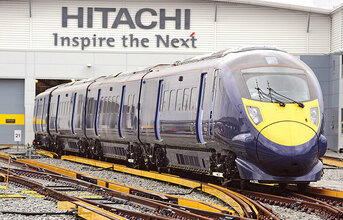
Tell us about Hitachi's business in India.
Hitachi's partnership with India dates back to 1930s with importing of table fans and later went on to supply steam engines followed by Turbines for the Bhakra Nangal Dam and the first steam locomotive to Indian railways in the year 1953. Since then Hitachi India has grown multifarious with presence of 27 group companies. The company operates in diverse industrial sectors such as Infrastructure, Railways, Energy, Construction Machinery, Healthcare, Information Technologies (IT), Automotive Systems and Payment Services amongst many others.
With regards to railways, the company has undertaken projects such as enhancing transport throughput with safety; dedicated freight corridor traversing the biggest industrial cluster between Delhi and Mumbai, like automatic signalling with train management & diagnostic systems between Rewari and Vadodara and the European Train Control System (ETCS) between Rewari and JN Port Trust.
Hitachi design traction motors till recently were manufactured by Indian Railways at their Chittaranjan Locomotive Works, which is a state-owned electric locomotive manufacturer based in India. How has been the company working with Indian Railways since 1953?
As I said earlier, the company's relationship with Indian Railways dates back to 1950s, when it delivered the first steam locomotive to India, shortly after independence. It was also one of the first companies to deliver electric locomotives DC 3000V, 3600 Horsepower and DC 1500V, 4500 horsepower. Its contributions to developing new standards in the Indian railways on critical
occasions, has translated to a trusted and enduring association between Hitachi and Indian Railways.
We have been closely following the ambitious expansion and modernisation plan by the Indian Railways. One of the objectives of the Railways is to segregate freight operations from the present mixed movement through the implementation of Dedicated Freight Corridors (DFCs) along the Golden Quadilateral. That would mean that the DFCs will help increase the speed of both freight as well as passenger trains. This is of much interest to us as it implies not only the construction of DFCs but also the upgrading of the existing corridors with new higher speed Trainsets, European Train Control System (ETCS) Level 2 signalling systems, to enable operations at higher speeds. In 2015, the company signed its prestigious railway contract for implementation of the signalling and telecommunication systems on western DFC.
In terms of the Indian Railways' Mission RAFTAR, we were involved in the commissioning of TPWS signalling for the first high speed corridor between Delhi and Agra for running the Gatimaan Express trains.
How do you look at the upcoming Mumbai-Ahmedabad high-speed railway project?
We already have an experience in developing such future-ready railways in multiple countries and hence have gathered multi-level, multi-cultural experience in solving a gamut of practical and local issues in the process. The country's first high-speed railway (HSR)
project in India is slated to connect the 508 kilometre stretch from Mumbai to Ahmedabad. The bullet train will be heralding in a new era with an operational speed of 320 km/hr and will also aim to adopt the Shinkansen culture of apologising to each and every passenger for even a slight delay. The project will be a decisive move forward in putting India at par with other countries in the world.
The company also caters to the Metro's solutions. Can you please elaborate on projects that you are undertaking in India?
Recently, we successfully implemented the signalling and telecommunication system for Noida metro project in a record time of 28 months. ANSALDO STS Transportation Systems India Pvt. Ltd., which is a Hitachi Group Company, was awarded the contract to deliver Communication Based Train Control (CBTC)-based Signalling with Automatic Operations (ATO) and the Telecommunications system for the 29.7km Aqua Line Metro from Noida Sector 51 to Delta Depot Station in Greater Noida. This project inaugurated recently in January 2019.
In addition, there are few more significant projects which we are associated includes Kolkata Metro East West and Navi Mumbai (CIDCO) Metro.
Driverless trains are not new to the railways or metros. Where do you think the future of autonomous technologies lie in the future?
Driverless trains are already in operations for many years in other parts of the world. We have been offering trains and CBTC signalling system to operate as driverless or unmanned operations (UTO). The company recently implemented the driverless system for Freight train operations for Rio Tinto in Australia.
Currently under implementation, we will soon witness Delhi Metro and many other Metros also operate on driverless trains on their network.
END


























